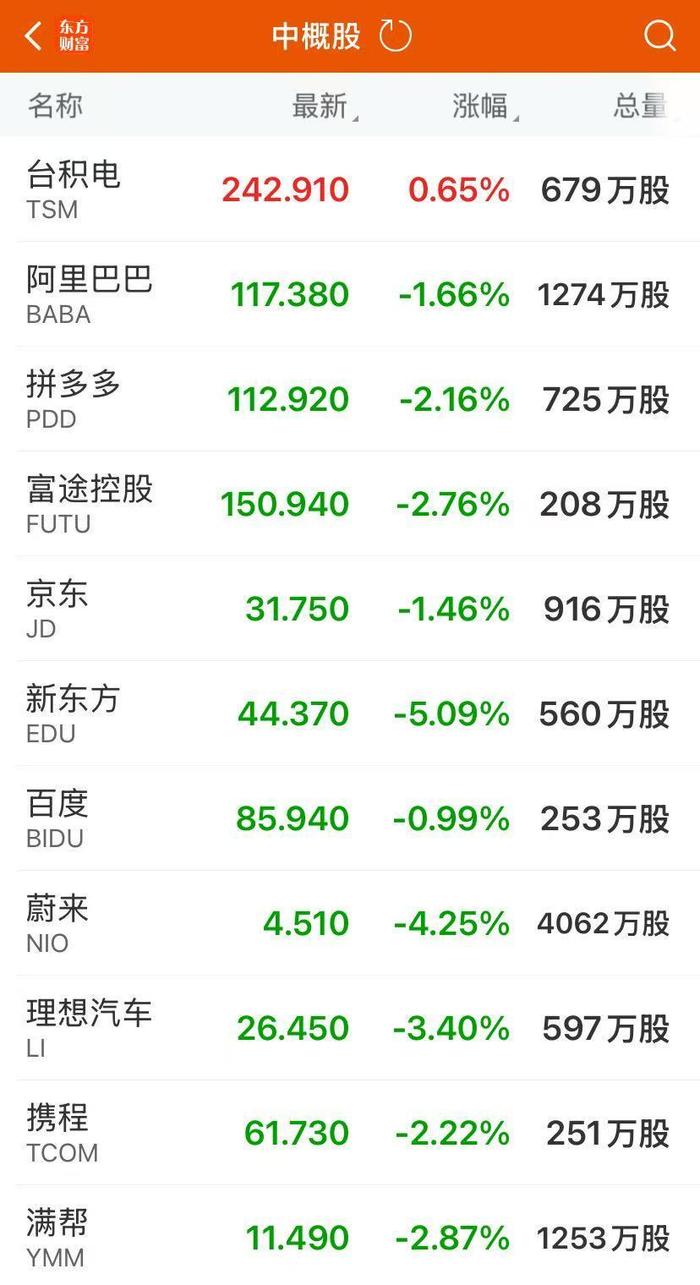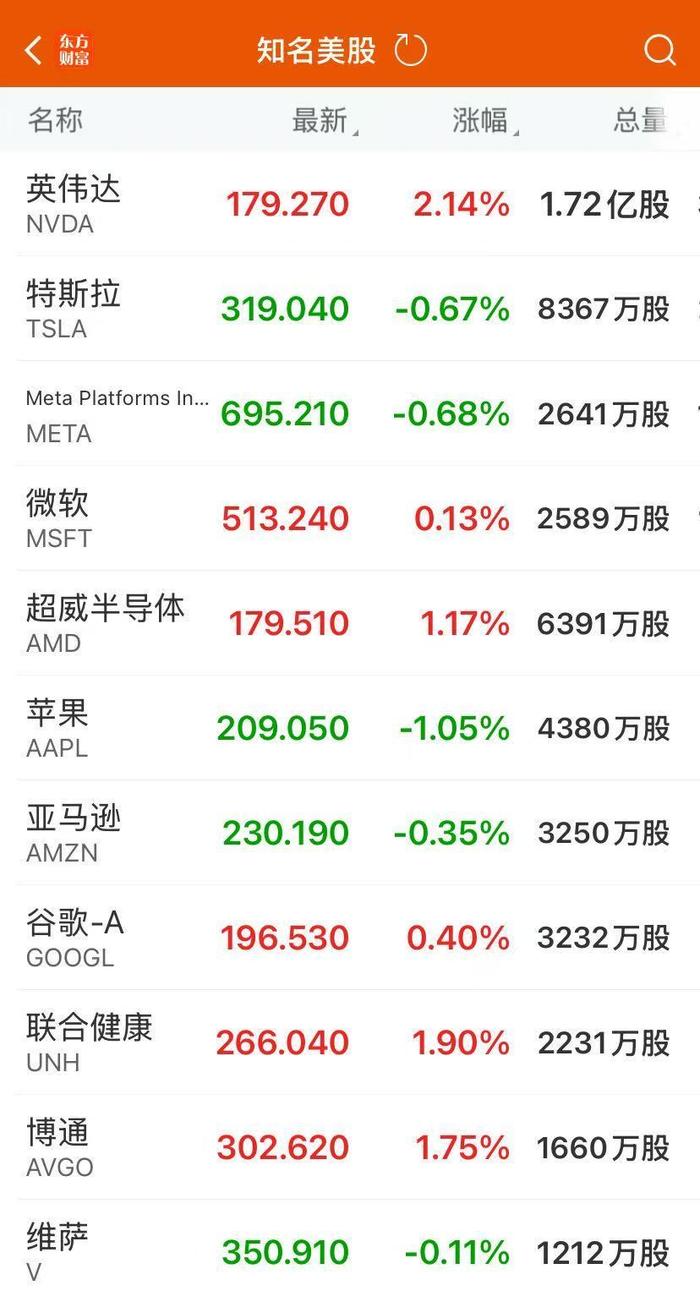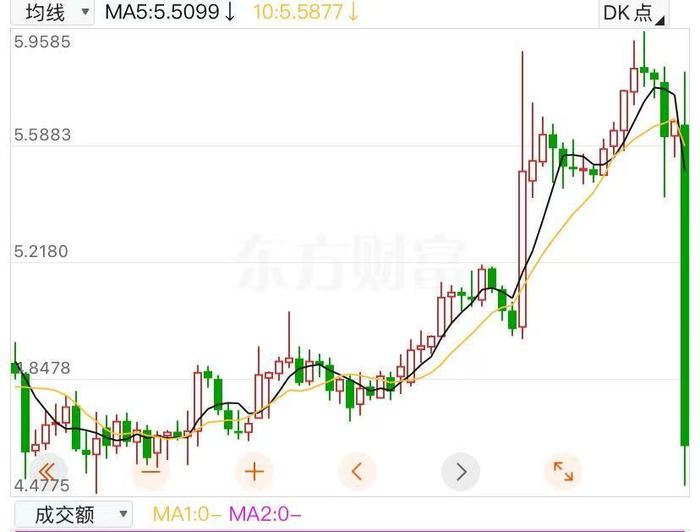


On July 30th, U.S. stock markets closed with mixed results, with the Dow Jones Industrial Average falling by 0.38%, the Nasdaq Composite rising by 0.15%, and the S&P 500 Index dropping by 0.12%. The Federal Reserve maintained its benchmark interest rate unchanged, as expected, but two members of the board opposed a rate cut for the first time in over 30 years. Powell stated that whether there would be a rate cut in September was still undecided, referring to economic information. Prices for gold and copper futures fell, while international oil prices rose above $70. European major stock indices saw slight gains. Popular Chinese concept stocks were mostly down. Trump called for a rate cut, but Powell did not provide a clear signal.
On Wednesday, Eastern Time (July 30), U.S. stock indexes closed with mixed results. By the close, the Dow Jones Industrial Average had fallen by 0.38%, the Nasdaq Composite had risen by 0.15%, and the S&P 500 Index had dropped by 0.12%. Traders expect a rate cut in September to be less than 50%, compared to around 60% previously.
Hot tech stocks experienced mixed results, with Nvidia surging more than 2%, Broadcom rising more than 1%, and Apple falling more than 1%.
The FTSE A50 index futures closed lower by 0.22% overnight, at 13985 points.
By the end of trading in New York on Wednesday, the CME Bitcoin futures contract for the main contract fell by 0.38% from Tuesday’s close, to below $118,000, breaking through $116,000 during the session.
By the end of trading in New York on Wednesday, the offshore Renminbi (CNH) against the dollar was quoted at 7.2113 Yuan, down 305 points from Tuesday’s close, with overall trading within the range of 7.1753~7.2146 Yuan.
Gold prices fell, with COMEX gold futures dropping by 1.72%, at $3266.90 per ounce; October contracts fell by 1.72%, at $3295.60.
By the end of trading in New York on Wednesday, COMEX copper futures briefly fell by 18.03%, at $4.6115 per pound, closing down by 17.7%.
International oil prices rose above $70, with WTI crude oil futures for September closing at $70.
00 USD/barrel, Brent crude futures closed at 73.24 USD/barrel on September 9.
In terms of news, the Federal Reserve decision continued to maintain the benchmark interest rate between 4.25% and 4.50%. Powell expressed uncertainty about the impact of policy changes on the economy, noting that tariff hikes have begun to be reflected in certain commodity prices but the overall economic and inflationary effects are still to be observed. Regarding whether there would be a rate cut in September, Powell stated, “no decisions have been made yet.”
Major U.S. tech stocks mostly fell
On Wednesday (30th), U.S. stock indexes experienced a slight rebound after a sharp decline at the end of trading, closing down by 0.38% for the Dow Jones Industrial Average, down 0.12% for the S&P 500, and up 0.15% for the Nasdaq.
On the market, most large technology stocks ended lower, with Nvidia up 2.13%, Google up 0.40%, Microsoft up 0.13%, Amazon down 0.37%, Tesla down 0.65%, Facebook down 0.67%, Apple down 1.07%.
Semiconductor stocks mostly ended higher, with Boson up 1.77%, Super Micro Systems up 1.17%, TSMC up 0.65%, ASML up 0.45%, ARM down 0.09%, Intel down 0.39%, Qualcomm down 1.88%.
Financial stocks strengthened, with Citigroup up 1.44%, Morgan Stanley up 0.96%, JPMorgan Chase up 0.92%, Bank of America up 0.08%, Goldman Sachs down 0.12%, Berkshire Hathaway down 0.18%, Wells Fargo down 1.02%.
U.S. copper futures plummeted nearly 18%, with precious metals and the concept of copper metal falling significantly, McMorran Copper & Gold down more than 9%, American Gold & Silver Company down more than 7%, Southern Copper Corporation down more than 6%, Americasilver Co. down more than 5%, Coltmining down more than 4%, Pan-American Silver down more than 3%.
In terms of news, according to reports, on July 30th local time, the White House announced that President Trump has signed an announcement declaring a tariff on several categories of imported copper products.
The announcement indicates that starting from August 1st, tariffs will be imposed on imported semi-finished copper products (such as copper pipes, copper wires, copper rods, copper plates, and copper tubes) and copper-intensive derivative products (such as pipe fittings, cables, connectors, and electrical components).
The White House stated that materials for copper input (such as copper ore, concentrate, galvanized copper, cathode copper, and anode copper) and copper waste are not subject to the “232 clause” or equivalent tariff restrictions.
Gold stocks closed lower across the board, with Royal Gold down 0.37%, Barrick Gold down 1.84%, Iger Mining down 2.34%, Newmont Mining down 2.58%, Franco Nevada down 2.73%, Goldman Sachs down 3.69%, and AngloGold down 5.24%.
The Nasdaq China Golden Dragon Index fell by 1.82%. In terms of popular Chinese concept stocks, Amer Sports rose by 1.33%, Bilibili fell by 0.74%, NetEase fell by 0.92%, Baidu Group fell by 0.99%, Good Future fell by 1.03%, JD Group fell by 1.44%, H酒店集团 fell by 1.62%, Alibaba fell by 1.69%, Beike fell by 1.87%, Baoji Science and Technology fell by 1.89%, XPeng Automobile fell by 1.96%, and Pinduoduo fell by 2.16%.
European major stock indices closed slightly higher, with the German DAX index up by 0.23% at 24,272.89 points, the French CAC40 index up by 0.06% at 7,861.96 points, and the UK’s FTSE 100 index up by 0.01% at 9,136.94 points.
The Federal Reserve maintained its interest rate unchanged for the fifth consecutive time.
On July 30th local time, the Federal Reserve concluded its two-day monetary policy meeting and announced that it would keep the federal funds rate target range at 4.25% to 4.
50% unchanged. This decision aligns with market expectations and is also the fifth consecutive time this year that the Federal Reserve has decided to keep interest rates unchanged.
The Federal Reserve’s policy statement indicated that “there has been a slowdown in U.S. economic growth” in the first half of the year, and if this trend continues, it could provide grounds for future rate cuts. However, the statement also stated, “the uncertainty surrounding the economic outlook remains high, with both inflation and employment targets facing risks.” Analysts believe that this statement reflects the Fed’s cautious stance—unwilling to cut rates lightly until the path of inflation and employment becomes clearer.
It is noteworthy that for the first time in over 30 years, two Federal Reserve Board members voted against the interest rate decision at this meeting. Analysis suggests that this indicates that the United States is exerting pressure on the Fed to lower interest rates, as seen in consensus-driven Federal Reserve.
It is reported that Michelle Bowman, the deputy governor responsible for the Fed’s regulatory affairs, and Christopher Waller, a board member, both voted against the decision. Both were appointed by President Trump and tend to support a reduction of 25 basis points from the federal funds rate target range at this meeting.
Earlier that day, it was mentioned that maintaining high interest rates is hurting the public, and the Fed should lower them.
On July 30th local time, Fed Chairman Jerome Powell said it was too early to conclude whether the Fed would cut the federal funds rate as expected by financial market expectations in September.
Powell stated during a press conference following the latest monetary policy meeting that the Fed had not made any decisions regarding the interest rate for September yet. Powell mentioned, “We will refer to relevant economic information before the next interest rate meeting.”
Key points from the Fed’s FOMC statement and Powell’s press conference:
1. The Fed maintains the federal funds rate target range at 4.25% to 4.50%, consistent with market expectations, marking the fifth consecutive time the Fed has decided to keep interest rates unchanged.
② The vote on the interest rate decision was 9 in favor, 2 against, with one director absent from the vote. Among those present, Directors Waller and Bauman supported a 25 basis point cut in interest rates, marking the first time since 1993 that two Federal Reserve Board members have raised objections to an interest rate decision.
③ The Federal Reserve reiterated that “the uncertainty surrounding the economic outlook remains high,” but removed the statement that “uncertainty has diminished.”
④ The interest rate statement downgraded its assessment of the U.S. economy, noting a slowdown in economic activity in the first half of the year, while maintaining the language that “labor market conditions remain robust” and inflation “remains slightly higher.”
⑤ The committee will continue to reduce its holdings of government bonds, agency debt, and agency-backed securities. The committee is firmly committed to achieving maximum employment and aims to bring inflation back to 2%.
① The Federal Reserve has not yet decided on the interest rate for September, “will refer to economic information before the next meeting.”
② Core PCE may have risen by 2.7% in June, with tariffs driving up some commodity prices, and long-term inflation expectations aligned with 2%.
③ Most estimates of effective tariff rates have remained largely unchanged, suggesting that the impact of tariffs on inflation is temporary, with 30% or 40% of core inflation stemming from tariffs.
④ Inflation is slightly above the target. Despite uncertainty, the economy remains solid.
⑤ Directors who have expressed dissent over the July Federal Reserve Board resolution statement will release related information in the coming days or weeks.
⑥ Powell mentioned his future role as a Fed director, stating there is no new information available at this time.